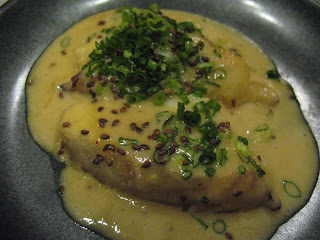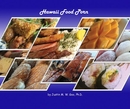My sister came home for Christmas, and this year we decided to treat ourselves to a very special dinner, to spend some brother/sister quality time together. I have read many, many sources saying that simply the best sushi on the island, is at Sushi Sasabune. Period. In fact, people just won't take you for a serious sushi afficionado unless you've been there. But I've also heard that it was extremely pricey. As it is the true sushi. The gourmet sushi. The sushi equivalent of buying the highest grade beluga caviar (at several hundreds of dollars an ounce, vs. the kind of caviar you can get from $15/jar at Foodland). So it is one of those, once in a lifetime experiences, that you simply must try. As a serious foodie, my sister is pretty much the only person I know who would appreciate and enjoy this level of sushi as much as myself. So this year, we finally decided to give it a try, and I was very, very, excited about going.
I have heard many things about Sushi Sasabune. For one thing, I've heard that the sushi chefs there are ridiculously strict about how to eat their sushi. Sushi must not be cut in half (Cutting the sushi in half, is like cutting a boat in half. The boat will sink.) Each piece must be eaten in one bite. Sushi should not be dipped in shoyu, unless allowed to do so by the chef. Dipping the sushi from the rice side, is a no no (as the rice will absorb too much of the shoyu and fall apart). Dipping the fish side only is difficult. The proper technique is to use the pickled ginger to dip in the shoyu and brush it over the sushi. Even when I called, the host wanted to make certain that I understood, "We serve only sushi. We don't serve Japanese food. We don't serve California rolls." These rules have given Sushi Sasabune an image similar to that of the infamous
Soup Nazi from Seinfeld.
The strict enforcement of these rules intimidates many people from wanting to try the experience. But somehow this doesn't bother me at all. For one thing, even in Western culture we've got rules about etiquette that we follow in a fine dining environment. You're not supposed to put your elbows on the table. You're supposed to use the right fork for the right course. You're not supposed to talk with your mouth full, or open your mouth while chewing. We don't complain about these rules because we've grown up with them. The Japanese rules of sushi etiquette just take a little learning beforehand, and you will have the same level of comfort. But besides that, I understand that when I cook a dish, many times I want my audience to eat it in a certain way, just so that I know that it tastes the way that I am trying to present it to people. If, for example, they add a lot of shoyu (or any other condiments for that matter), it will be saltier than I had intended. After spending a lot of time trying to find the right balance of seasonings and flavors, I don't want people to distrupt the flavors I'm trying to present. Some people may think that enjoying food should be adjusted as a matter of personal preference, but then it's not what I, as the chef, have created. You don't go up to the Mona Lisa and add a little flower in her hair because you think it would make her prettier. Likewise, I want to pay my respects to the sushi chef by eating it the way he wants to present it. In fact, if I'm paying this huge amount of money to eat there, I definitely want him to tell me how he thinks his creation is best enjoyed. I want to hear the story he has to tell, and not put words in his mouth. My only qualm would be if they were unfriendly, rude, or obnoxious about their rules. But they really weren't. They were as attentive, friendly, and welcoming as any other fine dining restaurant in town.
Naturally, we didn't bother to order anything. We went with the
omakase, meaning we left it up to the chef to decide what he wanted to serve us. This presumes he knows what his best dishes are, he knows what is fresh that day, and he will serve you what he thinks is best. So, what did I have at this ultra elite, fine dining sushi experience? What was the story that the chef wanted to tell? Here it is, course by course:
Albacore Tuna & Blue Fin Tuna Sashimi in Ponzu Sauce at Sushi Sasabune
First up, was an appetizer of albacore tuna (white) and blue fin tuna (red) in ponzu sauce. The first thing that I noticed, was that the tartnessof the ponzu sauce instantly woke up my mouth, and fired up all of my taste buds. A good opening gambit. The second thing I noticed was both tuna, were cut absolutely, unmistakably, perfect. There was not a single vein in any piece of fish whatsoever. It was incredibly smooth. Though both tuna, the albacore definitely tasted different from the blue fin. My sister liked the albacore better, whereas I thought the ponzu overpowered it a little. I liked the blue fin a little better, as I thought it had a stronger fish taste, but she thought the reverse.
Squid Stuffed with Blue Crab at Sushi Sasabune
My next dish was a squid stuffed with blue crab. The squid was a nice soft texture, but what made this dish was the crab. The crab inside was just incredibly creamy, and full of crab flavor. It puts any crab cake in the world to utter shame. The sweetness of the sauce below was counter balanced by the strong roasted flavor of the sesame seeds on top. All of which was just superb with the crab.
Hamachi Collar Nitsuke at Sushi Sasabune
My sister is allergic to squid. Once in Nanjing, China, she had some squid that made her eyelids swell so much, they essentially swelled shut, making her look like a blind cave salamander. So the chef happily took that allergy into accomodation and prepared her an alternate second course of hamachi collar. If you've never had it, hamachi collar is pretty much the best part of any fish you will ever eat. It is the most tender, perfect fish meat. And his preparation was an awesome nitsuke style dish. It was a very familiar shoyu flavor, and she just loved it.
Toro Nigiri at Sushi Sasabune
Our third course was the first actual sushi. In this case, it was
toro (or fatty tuna). Frankly, I was suprised to see this dish so early on. When you eat a piece of pear that's sweeter than an apple first, then you eat the piece of apple it seems kind of bland. The same goes for sushi. Usually you want your fattier pieces of fish to come later, otherwise you won't enjoy he leaner pieces as much. But in any case the toro was excellent. What I also immediately noticed, was that the rice was warm. Body temperature in fact. This is kind of odd when most places serve you chilled or room temperature rice. But I really liked the warm rice. It brought out the fish flavor more. Imagine a piece of butter on room temperature bread. Then imagine a piece of butter melting on warm bread. That is essentially the difference with the warm rice at Sasabune.
Flounder (top) & Amberjack (bottom) Nigiri at Sushi Sasabune
Our fourth course was a combination of amberjack and flounder sushi. The flounder has a crunchier texture, similar to king clam. Which was a nice contrast to the buttery, fatty, toro in the previous course. The amberjack had a nice piece of toasted garlic on it that gave the entire piece of sushi a very strong garlic taste. It was wonderfully garlicy, but I didn't taste the fish too much.
Hamachi Nigiriat Sushi Sasabune
Our fifth course was hamachi. I adore hamachi. It is my favorite sushi fish of all, so I had very high expectations here. Unfortunately, I was a little disappointed. On the downside, the wasabi was just a little too strong in my piece, so it really overpowered everything else. Also, the flavor of the fish just wasn't pronounced enough. It should have been much fattier, more buttery, but it was just lost to the wasabi. On the upside, that had one of the best textures I've had from any piece of hamachi anywhere. So the texture was awesome, but the flavor of the fish not strong enough. In fact, if there was one complaint my sister had throughout, this would be it.
Scallop (top) & Salmon (bottom) Nigiri at Sushi Sasabune
Our sixth course consisted of scallop and salmon. The salmon, like the hamachi, just didn't have a strong enough salmon flavor. It had a piece of pickled kelp on top which again overpowered the fish. Again, it had a fantastic texture, but not enough salmon taste. The scallop on the other hand was really huge, plump, and had one of the sweetest seafood tastes anywhere. It was super sweet.
Oyster Dynamite at Sushi Sasabune
Our seventh course was a baked oyster (sliced into 2 bites for you). It was hands down one of the plumpest, juicest oysters I've ever had. They cooked it just right too, so it was still plump and tender, and hadn't started to get shrivelled up or tough. It had a really strong oyster flavor, which was just complemented by the baked dynamite on top.
Blue Shrimp (top) & Mackeral (bottom) Nigiri at Sushi Sasabune
Our eighth course was a blue shrimp and spanish mackeral. This dish seemed very out of place to me. Following the oyster, both pieces seemed a little bland. I have had much sweeter shrimp in other places. So this dish was a little less memorable. By this time, my sister complained that she was getting full, but I convinced her the better stuff was still coming.
Snow Crab (left) and Mackeral (right) Nigiri at Sushi Sasabune
Our ninth course was a different type of mackeral and a snow crab. Again, the mackeral was not that memorable. But then always prefer the buttery grilled saba, to the kind of sour sashimi or sushi mackeral. The crab on the otherhand was fantastic. The chef took the roux (or as my wife likes to call it the "green stuff"), out of the head of he crab, and made it into a sauce that he drizzled on the crab itself. This nearly floored me. The combination of crab roux and sweet crab meat was just awesome. It gave it a truly intense crab flavor. It may just be the greatest piece of crab that I have ever put in my mouth.
Negitoro Nigiri at Sushi Sasabune
Or tenth course, was the
negitoro. Now, they serve negitoro at Genki Sushi, but that might as well be a completely different dish entirely. This negitoro is the signature dish at Sasabune. They take the fish and chopped it so fine, that it practically has the texture of whipped cream. By pulverizing the fish, they also draw out much more of the fish flavor, than the regular piece of toro at the beginning. It was superb, and easy to see why it's their signature dish. I thought that this might be the last dish, as it was their signature, but there was much more to follow.
Spiny Lobster at Sushi Sasabune
Our eleventh course, was a spiny lobster. The lobster was cooked absolutely perfectly. It was just the right balance of tender and firm. So it was just perfectly succulent. But by this time, my sister is seriously complaining that she's over stuffed, so she didn't get to enjoy it too much. Again, I thought that this might be the last dish, as lobster is a pretty substantial thing to end on, but we pressed on.
Unagi Over Tamago at Sushi Sasabune
Our twelfth course, was an unagi over a piece of tamago. This was kind of innovative and interesting to me, because the chef substituted tamago for sushi rice. The tamago was a very soft spongy texture, which is worlds better than the tamago you usually get in your bento from Shirokiya. But again, this dish seemed out of place for me, because it was far less interesting than the crab, or negitoro, or lobster. At this point, my sister decided she just couldn't stomach any more, and told the waiter to stop for her. I on the other hand elected to keep going, for two reasons. Firstly, I didn't want to stop short, and not get my full money's worth. Secondly, and more importantly, I didn't want to cut short the story the chef was telling. As I explained it to my sister, you don't read a mystery novel, and quit before you find out who done it! I wanted to ride the train to the very last stop to see where the chef was going with it.
Blue Crab Temaki at Sushi Sasabune
For my thirteenth course, I got a blue crab hand roll. Now this was the same blue crab that I had gotten at the very beginning. While still extremely flavorful and creamy, I couldn't really understand why the chef had elected to repeat himself. This story was starting to not make any sense to me. On the other hand, as it was a hand roll, I figured the chef was just trying to fill me up with rice, as you would towards the end of a meal for diners who are still hungry. While the crab was tasty, it was still kind of ordinary to me.
Butterfish with Monkfish Liver Sauce at Sushi Sasabune
For my fourteenth course, I got a butterfish. But instead of done, misoyaki style, as we're used to in the islands, the chef made a sauce out of monk fish liver and poured it over the butterfish. Monkfish liver has been called the foie gras of the sea, so I was very excited to get to try it. However, at this point, I asked the waiter how many more courses there were, and he told me that the chef just keeps going until you tell him to stop. A little alarmed now, I politely told him that that would be it for me. Since I was a little frazzled by this new information, I really didn't get to enjoy the butterfish that much.
Not understanding how the omakase concept worked at Sasabune had 3 huge drawbacks that threw a big damper on our evening. Firstly, my sister had a huge tummy ache, and she moaned practically the whole way home. Had she known we could've stopped at any time, she probably would've stopped way before hand, and saved herself some pain.
Secondly, my understanding was that it would be a fixed price for the omakase course, like a prix fixe menu. But, even though we hadn't ordered ala carte, they were charging us for each dish we ate. So as we were eating more and more, we were racking up the tab. Since almost 90% of the menu was imported from around the world (like Japan and New Zealand), with very little local ingredients, you would expect it to be pretty pricey. In total, for the whole evening (including tax and tip), we paid $250 for just the two of us! I was expecting it to be expensive, but that was even more than I had anticipated. Doing the calculation, it was roughly $10 per plate on average (compared to Genki Sushi where it is roughly $2 per plate). Sasabune, has a 4 plate per person minimum, so had we known, we could've spent $80 minimum for the two of us.
Thirdly, and the thing that was the most disappointing to me of all, was that this meant that there was no story that the chef was trying to tell. There was no logical progression from dish to dish, one leading to another, the chef building up to a climax and a denouement. This was just the chef slapping together whatever the hell he felt like making. This was especially disappointing, because like my example of the apple and the pear, certain foods must preceed others as to not be overpowered. For a restaurant that places so much emphasis on precisely how the food should be eaten and enjoyed, for the price I was paying for the chef's expertise and artistry, not having a planned progression was a huge let down. It's like hiring J.K.Rowling to come and play with your magnetic poetry board, rather than to write.
Having experienced probably 75% of their menu, the next time I visit Sasabune, I would probably just order ala carte. Conforming to their 4 plate minimum, I would probably pick the squid stuffed with blue crab, the oyster dynamite, the snow crab, and the negitoro (not necessarily in that order). I might get the lobster, or the albacore and blue fin tuna in ponzu sauce too. Then again, having experienced Sasabune once in my life, I think I'm pretty satisfied. I really did enjoy it. They certainly showed extremely high quality ingredients, and an absolute mastery over their preparation. My own lack of understanding should not be counted against them. I will say this for certain, that is one dining experience that I will never forget.




















































